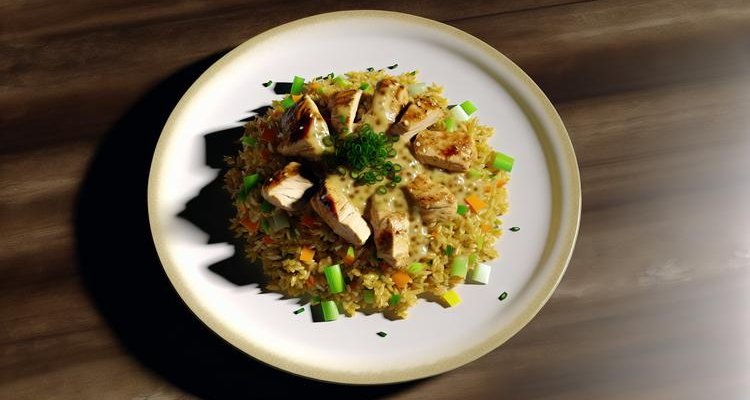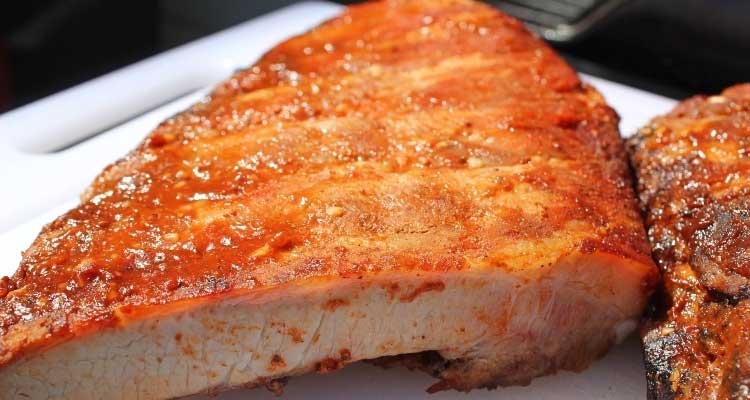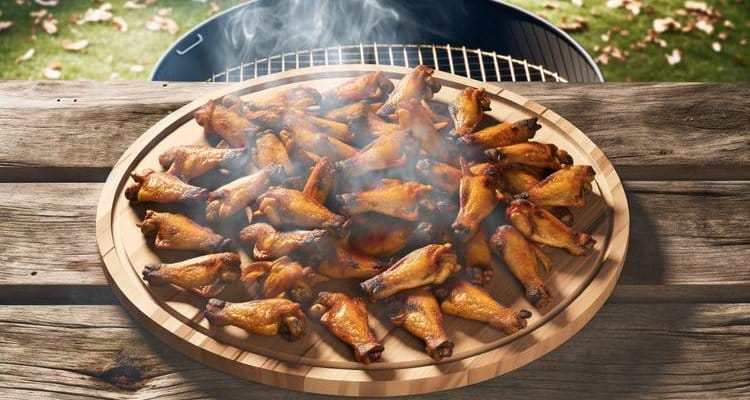
Smoked chicken wings combine two of the best qualities any wing can have: deep, smoky flavor and irresistibly crispy skin. Unlike traditional frying or baking, smoking infuses wings with a rich wood-fired taste that elevates them from ordinary appetizers to show-stopping centerpieces for game day, backyard gatherings, or family dinners.
The challenge with smoked wings has always been achieving that perfect crispy exterior while maintaining juicy, tender meat. This comprehensive guide will teach you the proven two-stage method that solves this problem, ensuring your smoked wings rival the best fried versions while delivering unique smoky flavor you can’t get any other way. If you’re new to smoking, check out our comprehensive smoking guide for fundamental techniques.
Quick Roundup List
- Equipment Needed: Smoker Options & Essential Tools
- Preparation: Wing Selection & Drying Techniques
- Temperature Guide: Two-Stage Method for Perfect Results
- Wood Selection: Apple & Cherry for Optimal Flavor
- Step-by-Step Process: Complete Smoking Instructions
- Crispy Skin Secrets: Techniques for Perfect Texture
- Sauce Options: Timing & Technique for Best Results
Why Smoke Chicken Wings?
Smoking chicken wings offers several advantages over other cooking methods. The low-and-slow cooking process allows smoke to penetrate the meat deeply, creating complex flavor profiles that change depending on your wood selection. Unlike grilling, which cooks wings quickly at high heat, smoking gives you more control over the final texture and allows you to infuse subtle or bold smoke flavors.
Beyond flavor, smoked wings are incredibly versatile. You can customize them with different wood types, seasonings, and sauces to create endless variations. They’re perfect for feeding crowds because smokers can handle large batches at once, and the forgiving nature of dark meat means slight temperature variations won’t dry out your wings like they might with chicken breast.
Equipment Needed for Smoking Chicken Wings
Successful wing smoking starts with having the right equipment. You don’t need expensive gear, but certain tools make the process significantly easier and more reliable. New to BBQ? Start with our BBQ basics guide to understand fundamental techniques.
Smoker Options
- Pellet Grills: Easiest for beginners with precise temperature control and automated feeding
- Charcoal Smokers: Provide authentic smoke flavor and require more hands-on management
- Electric Smokers: Consistent temperature with minimal effort, ideal for apartment balconies
- Gas Grills with Smoker Boxes: Budget-friendly option using equipment you may already own
Essential Tools
- Meat Thermometer: A reliable meat thermometer is non-negotiable for monitoring internal temperature accurately
- Long Tongs: For safely moving wings without piercing the skin
- Spray Bottle: Optional for spritzing wings with apple juice or water to maintain moisture
- Wire Rack: Helps with air circulation if your smoker grates are widely spaced
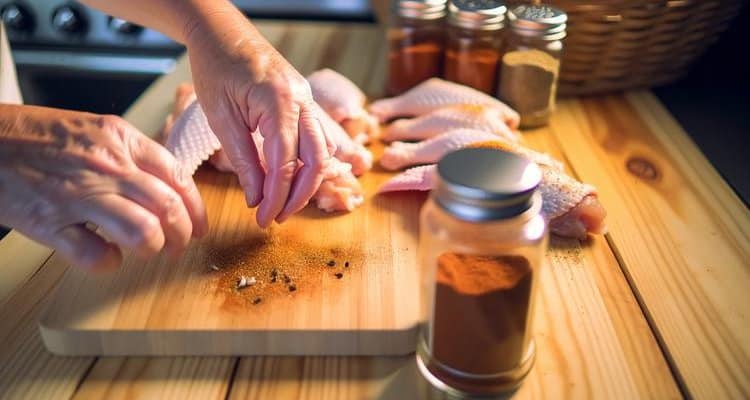
Selecting and Preparing Chicken Wings
Proper wing selection and preparation set the foundation for crispy, flavorful results. Start with fresh wings whenever possible, as they’ll have better texture than previously frozen options. If using frozen wings, thaw them completely in the refrigerator for 24 hours before smoking—never smoke frozen wings as they’ll cook unevenly and pose food safety risks.
You can purchase whole wings or pre-separated drumettes and flats. Whole wings are often more economical, and separating them yourself is simple: just cut through the two joints with a sharp knife or kitchen shears. Many pitmasters discard the wing tips as they have little meat, though you can save them for making chicken stock.
The Critical Drying Step
The single most important preparation step is thoroughly drying your wings. Pat each wing dry with paper towels, pressing firmly to remove all surface moisture. Moisture is the enemy of crispy skin—any water left on the surface will steam during cooking, resulting in rubbery, soggy skin.
For even better results, place your dried, seasoned wings uncovered on a wire rack in the refrigerator for 12-72 hours. This “dry brining” technique allows additional moisture to evaporate from the skin while the seasoning penetrates the meat. The longer drying time creates exceptionally crispy skin when smoked.
The Science of Crispy Skin
Understanding why baking powder works transforms good wings into great ones. Baking powder (not baking soda—they’re different!) raises the skin’s pH levels, which breaks down proteins more efficiently during cooking. This protein breakdown allows the skin to brown more evenly and become crispier.
When you coat wings with baking powder and salt, you create a dry brine that draws moisture to the surface, which then evaporates. This double action—moisture removal plus pH modification—is why baking powder is a secret weapon for crispy wings. Use about 1 tablespoon of baking powder per pound of wings, combined with 1 teaspoon of salt.
Best Temperature for Smoking Chicken Wings
Temperature management is where many beginners struggle with smoked wings. The problem is simple: traditional low smoking temperatures (225°F) that work beautifully for brisket or pork shoulder create rubbery chicken skin. The solution is a two-stage cooking method that combines low-temperature smoking for flavor with high-heat finishing for texture.
| Temperature | Cooking Time | Skin Texture | Best Use |
|---|---|---|---|
| 225°F | 1-1.5 hours | Rubbery (needs crisping) | Smoking stage only |
| 250°F | 1-1.25 hours | Slightly better but still soft | Smoking stage with faster cook |
| 275°F | 50-60 minutes | Improved but requires finishing | Smoking stage for time-saving |
| 375-425°F | 10-15 minutes | Crispy and golden | Crisping/finishing stage |
The two-stage method works like this: smoke wings at 225-250°F until they reach an internal temperature of 155-160°F, absorbing maximum smoke flavor. Then increase heat to 375-425°F (or transfer to a hot oven) and cook until the skin crisps and internal temperature reaches 165-175°F. This approach delivers both the smoky flavor you want and the crispy texture you need.
Understanding Internal Temperature
While 165°F is the USDA-recommended minimum safe temperature for chicken, wings are actually better at 175°F. This higher temperature isn’t just safe—it’s optimal for tenderness.
| Internal Temp | Safety | Texture | Reason |
|---|---|---|---|
| 165°F | Safe (USDA minimum) | Cooked but can be chewy | Kills harmful bacteria |
| 175°F | Safe | Fall-off-the-bone tender | Breaks down connective tissue and collagen |
Wings contain more connective tissue than other chicken parts. At 165°F, this tissue is cooked but still somewhat tough. At 175°F, the collagen breaks down into gelatin, creating that desirable tender texture where meat easily pulls away from the bone. The extra 10 degrees makes a dramatic difference in eating experience.
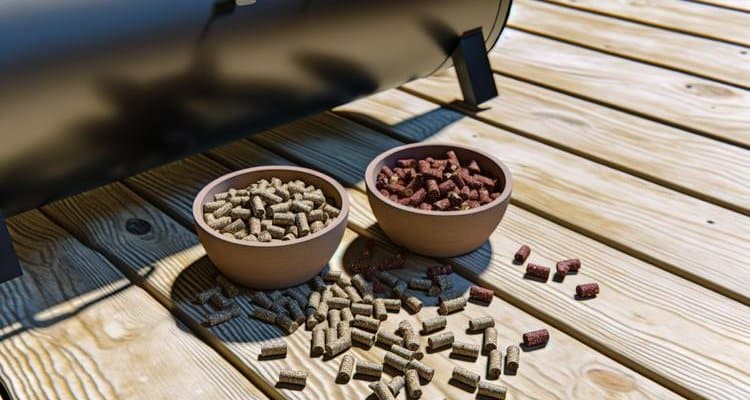
Best Wood for Smoking Chicken Wings
Wood selection dramatically impacts your final flavor profile. Chicken’s mild flavor can be easily overwhelmed by strong woods, so choosing the right variety is crucial. Learn more about wood pellet selection for different flavor profiles.
| Wood Type | Flavor Profile | Intensity | Recommendation for Wings |
|---|---|---|---|
| Apple | Light, fruity, slightly sweet | Mild | ⭐ Excellent – Top choice |
| Cherry | Mild, sweet, slightly tart | Mild | ⭐ Excellent – Top choice |
| Pecan | Rich, nutty, subtle | Medium-Mild | ✔ Good option |
| Hickory | Strong, bacon-like, bold | Strong | ⚠ Use sparingly – can overpower |
| Mesquite | Very strong, earthy, intense | Very Strong | ✗ Avoid – too bitter for wings |
Apple and cherry woods are the gold standard for chicken wings. Both provide enough smoke flavor to be noticeable without overwhelming the natural chicken taste. They also complement most seasonings and sauces beautifully.
Avoid mesquite and use hickory sparingly. These strong woods are excellent for beef and pork, but their intense smoke can make wings taste bitter and over-smoked. If you do use hickory, blend it 50/50 with apple or cherry wood.
Seasoning and Flavoring Options
Seasoning is where you personalize your wings. There are four main approaches, each with distinct advantages. You can combine methods—for example, dry rub for the smoking stage and glaze for the finishing stage. For pre-made options, check out our guide to the best BBQ rubs and seasoning sets from championship-proven brands.
| Method | Timing | Benefits | Best For |
|---|---|---|---|
| Dry Rub | Apply 30 min to overnight before smoking | Creates flavorful crust, enhances crisping | Those who prefer dry wings or want maximum crisp |
| Brine | 2-12 hours before smoking | Increases moisture retention, adds flavor throughout | Insurance against dryness with longer smoking |
| Marinade | 30 min to 24 hours before smoking | Deep flavor penetration, tenderizes meat | Bold flavors like teriyaki, BBQ, or spicy marinades |
| Glaze | Last 10-15 minutes of high-heat cooking | Adds sticky-sweet coating, caramelizes beautifully | Sweet or tangy sauces that benefit from caramelization |
Simple All-Purpose Dry Rub Recipe
Yield: Enough for 3 pounds of wings
- 1 tablespoon baking powder
- 1 tablespoon paprika
- 2 teaspoons garlic powder
- 2 teaspoons onion powder
- 1 teaspoon black pepper
- 1 teaspoon salt
- 1 teaspoon brown sugar
- ½ teaspoon cayenne pepper (optional, for heat)
Instructions: Mix all ingredients thoroughly. Pat wings completely dry, then toss in rub until evenly coated. Let rest 30 minutes at room temperature before smoking, or refrigerate uncovered for up to 24 hours for maximum flavor.
Smoky BBQ Dry Rub Recipe
Yield: Enough for 3 pounds of wings
- 1 tablespoon baking powder
- 2 tablespoons brown sugar
- 1 tablespoon smoked paprika
- 1 tablespoon chili powder
- 2 teaspoons garlic powder
- 1 teaspoon cumin
- 1 teaspoon salt
- ½ teaspoon black pepper
Instructions: Combine all spices. Apply to dried wings and let rest as above. This rub creates a sweeter, smokier profile with deeper color.
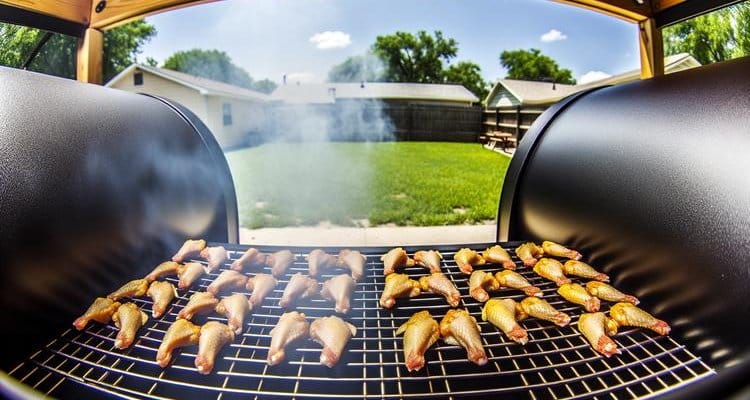
Step-by-Step: How to Smoke Chicken Wings
Follow this proven process for consistently excellent results. The key is patience during the smoking stage and attentiveness during the crisping stage.
Step 1: Preparation (30 minutes before smoking)
- Remove wings from refrigerator and pat completely dry with paper towels
- If using baking powder, toss wings with 1 tablespoon baking powder and 1 teaspoon salt per pound
- Apply your chosen dry rub, coating evenly on all sides
- Let wings rest at room temperature for 30 minutes while smoker preheats (this helps them cook more evenly)
Why this works: Bringing wings to room temperature prevents a cold center when the outside reaches target temperature. The 30-minute rest allows the dry rub to begin penetrating the meat while moisture continues evaporating from the surface.
Step 2: Setup Smoker (15 minutes)
- Preheat smoker to 225-250°F using your preferred method
- Add wood chunks or pellets (apple or cherry recommended)
- If using a water pan, fill it to help maintain humidity and stable temperature
- Wait for clean, thin blue smoke—thick white smoke indicates incomplete combustion and tastes bitter
Why this works: Clean blue smoke means the wood is burning efficiently at the right temperature, producing flavorful smoke compounds without harsh, acrid flavors. White smoke contains more creosote and will make wings taste sooty.
Step 3: Smoking Stage (1-1.5 hours)
- Arrange wings on smoker grates with space between each piece—don’t overcrowd
- Close lid and maintain 225-250°F temperature
- Smoke without opening the lid for first 45 minutes (resist the urge to peek)
- After 45 minutes, check internal temperature in the thickest part of several wings
- Continue smoking until wings reach 155-160°F internal temperature
- Total time: typically 60-90 minutes depending on wing size and smoker temperature
Why this works: The low temperature allows maximum smoke absorption while gently rendering fat from under the skin. Spacing wings properly ensures even heat distribution and smoke circulation. Avoiding frequent lid opening maintains consistent temperature—each peek can drop temperature 25°F or more.
Step 4: Crisping Stage (10-15 minutes)
- When wings reach 155-160°F, remove them from smoker temporarily
- Increase smoker temperature to 375-425°F (or preheat oven to 425°F)
- Once high heat is established, return wings to smoker (or transfer to oven on a wire rack)
- Cook 5-7 minutes, then flip wings
- Cook another 5-7 minutes until skin is crispy and golden brown
- Check internal temperature—should reach 165-175°F
- Watch carefully to prevent burning; wing tips can char quickly
Why this works: High heat renders remaining fat from under the skin and evaporates any surface moisture, creating the Maillard reaction that browns and crisps the exterior. The flip ensures even crisping on both sides.
Step 5: Resting and Serving (5 minutes)
- Remove wings to a clean platter
- Let rest 5 minutes before saucing or serving
- If adding sauce, heat it first, then toss wings in warm sauce
- Serve immediately for maximum crispiness
Why this works: Resting allows juices to redistribute throughout the meat rather than running out when bitten. Heating sauce before tossing prevents cold sauce from softening the crispy skin you worked hard to achieve.
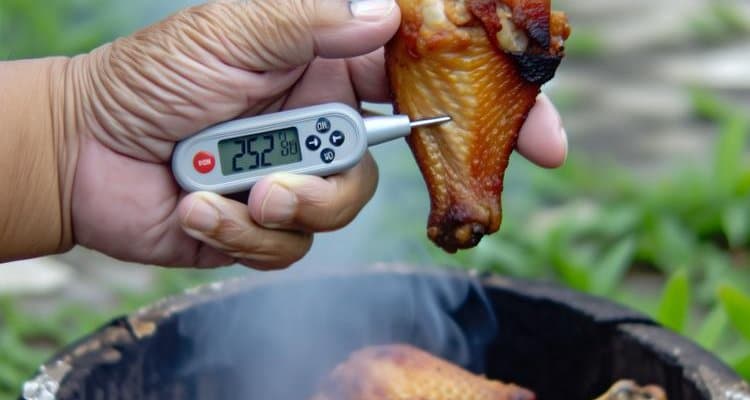
Getting Crispy Skin on Smoked Wings
Crispy skin is the holy grail of smoked wings, and it requires understanding what causes rubbery skin in the first place. Chicken skin is mostly fat and water. At low smoking temperatures (225-250°F), fat slowly renders but water doesn’t evaporate quickly enough, leaving skin soft and rubbery.
Critical Crisping Techniques
1. Thorough Drying: Before any seasoning touches your wings, they must be bone-dry. Use paper towels to press firmly on all surfaces, absorbing every bit of moisture. Even small amounts of water will steam during cooking, preventing crisping.
2. Baking Powder Application: As explained earlier, baking powder raises skin pH and draws moisture to the surface where it can evaporate. This is the single most effective technique for crispy wings without frying.
3. Two-Stage Temperature Method: This is non-negotiable. Low heat alone will never crisp chicken skin adequately. You must finish with high heat (375-425°F) to render the final bits of fat and drive off remaining moisture.
4. High Heat Duration: Don’t rush the crisping stage, but don’t overcook either. You need 10-15 minutes total at high heat, flipping halfway through. Less time leaves skin soft; more time risks drying out the meat.
Alternative Crisping Methods
If your smoker can’t reach 400°F+, you have options:
Oven Finish: Transfer smoked wings to a wire rack on a baking sheet. Place in a 425°F oven for 10-12 minutes, flipping once, until skin crisps.
Deep Fry Finish: For maximum crispiness, heat peanut oil to 375°F and fry smoked wings for 2-3 minutes. This creates restaurant-quality crispy skin while maintaining the smoked flavor.
Cornstarch Coating: Instead of or in addition to baking powder, dust wings with cornstarch before smoking. The starch absorbs moisture and crisps beautifully when exposed to high heat.
Saucing Smoked Chicken Wings
Timing is everything with wing sauce. Apply sauce during the low-temperature smoking phase and it will burn, discolor, and taste bitter. Apply cold sauce to hot wings and it will make crispy skin soggy. The solution: sauce after smoking, using heated sauce.
Proper Saucing Technique
- Heat your chosen sauce in a small saucepan until warm (not boiling)
- After wings complete the crisping stage and rest for 5 minutes, place them in a large bowl
- Pour warm sauce over wings and toss gently to coat evenly
- Serve immediately with extra sauce on the side for dipping
Classic Sauce Options
Buffalo Sauce: Combine ½ cup Frank’s RedHot sauce, ¼ cup melted butter, 1 tablespoon white vinegar, and ½ teaspoon garlic powder. Heat and toss.
BBQ Glaze: Use your favorite BBQ sauce thinned slightly with apple juice for better coating. Add a splash of hot sauce for depth.
Honey Sriracha: Mix ½ cup sriracha, ¼ cup honey, 2 tablespoons melted butter, and 1 tablespoon lime juice. Balance sweet and heat to taste.
Garlic Parmesan: Toss wings in melted butter mixed with minced garlic, then dust generously with grated Parmesan cheese and fresh parsley.
Troubleshooting Common Problems
Even experienced pitmasters encounter issues. Here are solutions to the most common smoked wing problems:
| Problem | Cause | Solution |
|---|---|---|
| Rubbery, soft skin | Only smoked at low temp, no crisping stage | Always finish with high heat (375-425°F) for 10-15 minutes |
| Dry, tough meat | Overcooked past 180°F or cooked too long | Use meat thermometer, remove at 175°F max; consider brining |
| Not enough smoke flavor | Smoking time too short or wrong wood | Smoke for full 60-90 minutes; use mild woods like apple/cherry |
| Too smoky or bitter taste | Strong wood (mesquite/hickory) or dirty smoke | Switch to apple or cherry wood; ensure thin blue smoke, not white |
| Uneven cooking | Overcrowding on grates or hot spots in smoker | Space wings properly; rotate wing positions halfway through |
| Wings sticking to grates | Grates not oiled or wings moved too soon | Oil grates before cooking; don’t flip until skin releases easily |
| Burned wing tips | Too much direct heat during crisping | Watch closely during high-heat stage; use indirect heat if possible |
Storing and Reheating Smoked Wings
Properly stored smoked wings stay delicious for days and reheat beautifully with the right technique.
Storage Guidelines
Refrigerator: Let wings cool to room temperature (within 2 hours of cooking for food safety). Store in an airtight container or wrapped tightly with plastic wrap for up to 3-4 days.
Freezer: Freeze wings in a single layer on a baking sheet until solid, then transfer to freezer bags. This prevents them from sticking together. Properly frozen wings last 2-3 months. Thaw overnight in refrigerator before reheating.
Best Reheating Method
Never microwave wings—it makes skin soggy and rubbery. Instead, use the oven:
- Preheat oven to 350°F
- Arrange wings on a wire rack over a baking sheet (this allows air circulation)
- Heat for 5-6 minutes
- Flip wings and heat another 5-6 minutes
- For extra crispy skin, increase oven to 400°F for final 2-3 minutes
This method reheats wings evenly while re-crisping the skin, making them taste freshly cooked.
Frequently Asked Questions
What temperature should I smoke chicken wings at?
Smoke wings at 225-250°F for the initial smoking stage (60-90 minutes), then increase to 375-425°F for the crisping stage (10-15 minutes). The low temperature absorbs smoke flavor while the high temperature crisps the skin. This two-stage method is essential for both flavor and texture.
How long does it take to smoke chicken wings?
Total cooking time is 1.25 to 2 hours: 60-90 minutes at 225-250°F for smoking, plus 10-15 minutes at 375-425°F for crisping. Exact time depends on wing size, smoker temperature consistency, and how often you open the lid. Always use a meat thermometer rather than relying solely on time.
How do I get crispy skin on smoked chicken wings?
Four critical techniques ensure crispy skin: (1) Pat wings completely dry before seasoning, (2) Use 1 tablespoon baking powder per pound of wings, (3) Finish with high heat (375-425°F) for 10-15 minutes after smoking, and (4) Never sauce wings with cold sauce. The combination of moisture removal, pH modification, and high heat creates restaurant-quality crispy skin.
Can I smoke frozen chicken wings?
No, never smoke frozen wings. They must be completely thawed first. Frozen wings cook unevenly, with the outside overcooking before the inside reaches safe temperature. They also retain excess moisture that prevents crispy skin. Thaw wings in the refrigerator for 24 hours before smoking.
What wood is best for smoking chicken wings?
Apple and cherry woods are the best choices for chicken wings. Both provide mild, slightly sweet smoke that complements chicken without overwhelming it. Avoid mesquite (too strong and bitter) and use hickory sparingly (can overpower wings). Pecan is also a good option for a slightly nuttier flavor profile.
Do I need to brine chicken wings before smoking?
Brining is optional but helpful. Wings have enough fat to stay moist without brining, but a simple salt-water brine (¼ cup salt per quart of water, 2-4 hours) adds insurance against dryness and enhances flavor. Brining is most beneficial if you’re smoking for extended periods or your smoker runs hot.
Should I sauce wings before or after smoking?
Always sauce after smoking, never before. Sauce applied during the low-temperature smoking stage will burn, discolor, and develop bitter flavors. Instead, heat your sauce separately and toss wings in warm sauce immediately after they finish the high-heat crisping stage.
Do I need to flip wings when smoking?
Flipping is not necessary during the low-temperature smoking stage if heat is indirect and consistent. However, you should flip wings once during the high-heat crisping stage (at the 5-7 minute mark) to ensure both sides crisp evenly. Flipping too often during smoking causes heat loss and extends cooking time.
What internal temperature should smoked wings reach?
The USDA minimum safe temperature is 165°F, but wings are better at 175°F. The higher temperature breaks down connective tissue and collagen in wings, creating fall-off-the-bone tenderness. Check temperature in the thickest part of the meat, avoiding bone contact for accurate readings.
Can I smoke wings on a pellet grill?
Yes, pellet grills are excellent for smoking wings. They maintain consistent temperatures easily and most models can reach the 400°F+ needed for crisping. Use apple or cherry pellets for best flavor. Set your pellet grill to 225-250°F for smoking, then increase to 400-450°F for the crisping stage. If you’re considering a pellet grill, check out our reviews of the best Pit Boss pellet grills or explore electric smoker options for easy temperature control.
How do I prevent wings from sticking to the grill grates?
Two methods prevent sticking: (1) Oil your grill grates before cooking using a paper towel soaked in high-temperature oil, or (2) Lightly coat wings with oil before seasoning. Also, don’t try to flip or move wings too early—they’ll release naturally from the grates once a crust forms (usually after 30-40 minutes).
Can I make smoked wings ahead of time?
Yes, smoked wings are excellent make-ahead food. Smoke wings completely, let cool, and refrigerate for up to 3 days. When ready to serve, reheat in a 350°F oven on a wire rack for 10-12 minutes, then increase heat to 400°F for final 2-3 minutes to re-crisp the skin. They’ll taste freshly made.
Conclusion
Mastering smoked chicken wings requires understanding the science behind crispy skin and implementing the two-stage cooking method. By smoking at low temperatures (225-250°F) for maximum flavor absorption, then finishing with high heat (375-425°F) for crispy texture, you achieve results that rival the best fried wings while adding unique smoky depth.
The key takeaways are simple: dry your wings thoroughly, use baking powder for pH modification, choose mild woods like apple or cherry, monitor temperature with a reliable thermometer, and never skip the high-heat crisping stage. These techniques transform ordinary wings into extraordinary centerpieces for any gathering.
Remember that food safety requires a minimum internal temperature of 165°F, but 175°F produces superior tenderness by breaking down connective tissue. Experiment with different rubs, woods, and sauces to discover your signature style, but always maintain the fundamental two-stage process for consistently excellent results.
Now it’s time to fire up your smoker and put these techniques into practice. Your next game day, backyard party, or family dinner deserves wings that deliver both authentic smoke flavor and irresistible crispy skin. Happy smoking!
Contents
- Quick Roundup List
- Why Smoke Chicken Wings?
- Equipment Needed for Smoking Chicken Wings
- Selecting and Preparing Chicken Wings
- Best Temperature for Smoking Chicken Wings
- Best Wood for Smoking Chicken Wings
- Seasoning and Flavoring Options
- Step-by-Step: How to Smoke Chicken Wings
- Getting Crispy Skin on Smoked Wings
- Saucing Smoked Chicken Wings
- Troubleshooting Common Problems
- Storing and Reheating Smoked Wings
- Frequently Asked Questions
- Conclusion

